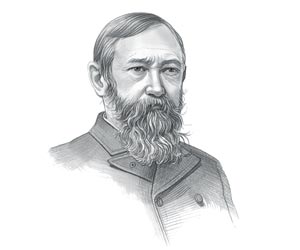|
It was also the period of rapid Urbanization in
America and the establishment of the Ellis Island
Immigration Process.
President Benjamin Harrison represented the Republican political party
which influenced the domestic and foreign policies of
his presidency. The major accomplishments and the
famous, main events that occurred during the time that
Benjamin Harrison was president included the First
Pan-American Conference in 1889, the Sherman Anti-Trust
Act (1890), the Sherman Silver Purchase Act (1890) and
the McKinley Tariff of 1890.
Benjamin Harrison
died of pneumonia on March 13, 1901, aged 67. The next president was
Grover
Cleveland.
Birthday:
August 20, 1833
Place of Birth:
Indiana
Political Party:
Republican
Nickname:
Human Iceberg
Number: 23rd
President
Vice President:
Levi P. Morton
Age at Inauguration:
55
Height: 5 feet
6 inches
Weight: 160
pounds
First Lady:
Caroline Harrison and Mary McKee
Religion:
Presbyterian
Date of Death:
March 13, 1901
Date of Benjamin
Harrison
Presidency: March 4,
1889 to March 4, 1893
The Nickname of Benjamin Harrison: Human Iceberg
The nickname of President Benjamin Harrison provides an insight into how the man
was viewed by the American public during his presidency. The meaning
of the nickname "Little Ben" refers to his small stature whilst the
nickname of "Human Iceberg" refers to his stern, cold manner when
communicating with people, although he managed to convey a warmer
image when giving speeches.
Character and Personality Type of Benjamin Harrison
The character traits of President Benjamin Harrison can be described
as reserved, intelligent, formal, aloof and diligent. It has been speculated that the Myers-Briggs
personality type for Benjamin Harrison is an ISTJ (Introversion, Sensing,
Thinking, Judgment). A reserved, well-regulated and serious
character and a strong traditionalist. Benjamin Harrison Personality type:
logical, organized, sensible, thorough and dependable.
Accomplishments of Benjamin Harrison and the Famous Events during his Presidency
The accomplishments of Benjamin Harrison and the most famous events during his
presidency are provided in
an interesting, short summary format
detailed below.
Billion Dollar Congress
Summary of the Billion Dollar Congress: The
Billion Dollar Congress
was the nickname given to the 51st Congress because it
was the first to pass a billion dollar budget. The laws passed
during Benjamin Harrison's term in office included the costly
Dependent Pension Bill that provided benefits to Union veterans
and their families. The
'Billion Dollar Congress' also approved
the cost of naval expansion.
1890 Sherman Antitrust Act
Summary of the Sherman Antitrust Act: The 1890
Sherman Antitrust Act
was first measure passed by Congress to prohibit monopolies in order
to maintain free competition in business.
McKinley Tariff
Summary of the McKinley Tariff: The
McKinley Tariff
was a protective tariff (tax),
became law on October 1, 1890 and was framed by future president
William McKinley. The McKinley Tariff raised the average duty on
foreign imports to almost 50%
protect the nation's home-grown goods from cheaper priced foreign
items.
Ellis Island
Summary of Ellis Island: The
Ellis Island immigration center was opened on January 1, 1892 in
Upper New York Bay as a federal immigration inspection station.
1888 Ghost Dance Movement
Summary of the Ghost Dance Movement: The second
Ghost Dance Movement
emerged in 1888 led by Wovoka, of the Paiute Indian
tribe. In December 1890 U.S. Army officers tried to arrest the Sioux
Chief Sitting Bull who supported the Ghost Dance movement and was
killed in the gun battle at the Standing Rock Reservation.
1890 Wounded Knee Massacre
Summary of the Wounded Knee Massacre: The Ghost Dance Movement
effectively ended at the
Wounded Knee Massacre
on
December 29, 1890
in which 400 men, women and children of the Lakota Sioux were
massacred by the 7th Cavalry. |

